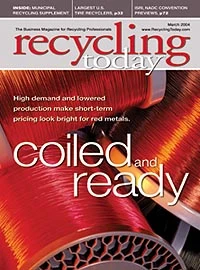CERL FINDS LEAD LEVELS NEGLIGIBLE
Results of a study of crushed concrete that included slabs of material coated with lead-based paint indicate the traces of lead are well below dangerous levels.
Attendees of the C&D World Exposition & Conference in New Orleans in late January were the first to hear the encouraging results, presented by Steve Cosper of the U.S. Army Construction Engineering Research Lab (CERL).
Cosper and CERL conducted the study on concrete debris generated at the demolition site of the Fort Ord complex in California. The Construction Materials Recycling Association (CMRA) and the National Association of Demolition Contractors (NADC) funded the study.
Although Cosper is still finalizing the full draft of his report, he offered show attendees a preview.
Noting that 400 parts per million (ppm) is the EPA limit for material to not be considered a hazardous waste, Cosper said that only paint chips tested alone surpassed this limit at 3,500 ppm following TCLP (toxicity characteristic leaching procedure) testing methods.
Otherwise, concrete fines generated by crushers on the site tested at 110 ppm; crushed concrete tested at 17 ppm; and soil located near the crushing plants tested at 30 to 60 ppm.
Air quality tests revealed that equipment operators working in the area were unlikely to encounter hazards.
Cosper noted that the crushing contractor did a good job controlling dust, but that at 110 ppm, enough lead is in the fines stream to "merit careful handling."
He said aggregates from a mixed stream of bare and painted concrete should be suitable for road base and other desired end markets.
Carpet Recycling Grants Available
The Carpet America Recovery Effort (CARE) is accepting grant proposals for programs that provide for recycling or reuse of post-consumer carpet or that increase the demand for products made from the material.
Grants of up to $50,000 are available to private sector applicants in three categories: intermediate processing and end-use; enhancement of the collection infrastructure; and research and development of markets.
Proposals are evaluated on waste stream impact, probability of program success, palling/cost effectiveness, need, technology transfer and sourcing end markets.
More information is available at www.carpetrecovery.org/grants/index.asp.
Get curated news on YOUR industry.
Enter your email to receive our newsletters.

Explore the March 2004 Issue
Check out more from this issue and find your next story to read.
Latest from Recycling Today
- Green Cubes unveils forklift battery line
- Rebar association points to trade turmoil
- LumiCup offers single-use plastic alternative
- European project yields recycled-content ABS
- ICM to host colocated events in Shanghai
- Astera runs into NIMBY concerns in Colorado
- ReMA opposes European efforts seeking export restrictions for recyclables
- Fresh Perspective: Raj Bagaria






